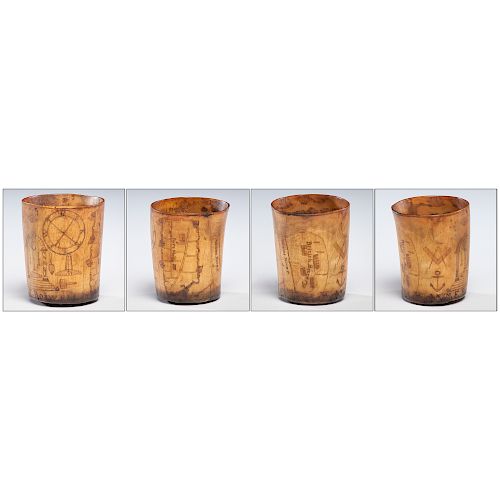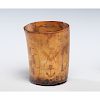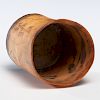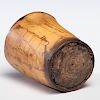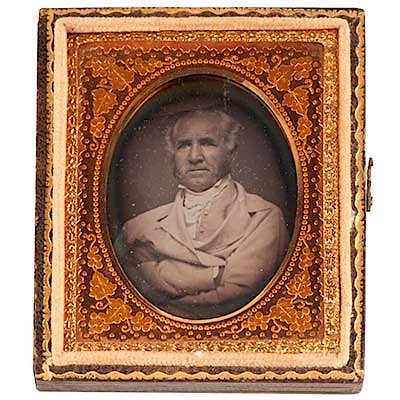War of 1812 Horn Cup of Colonel William E. Boswell, 10th Kentucky Light Infantry, Depicting Fort Meigs
About Seller
6270 Este Ave.
Cincinnati , OH 45232
United States
With offices in Cincinnati, Cleveland and Denver, Cowan’s holds over 40 auctions each year, with annual sales exceeding $16M. We reach buyers around the globe, and take pride in our reputation for integrity, customer service and great results. A full-service house, Cowan’s Auctions specializes in Am...Read more
Two ways to bid:
- Leave a max absentee bid and the platform will bid on your behalf up to your maximum bid during the live auction.
- Bid live during the auction and your bids will be submitted real-time to the auctioneer.
Bid Increments
| Price | Bid Increment |
|---|---|
| $0 | $25 |
| $500 | $50 |
| $1,000 | $100 |
| $2,000 | $250 |
| $5,000 | $500 |
| $10,000 | $1,000 |
| $20,000 | $2,500 |
| $50,000 | $5,000 |
| $100,000 | $10,000 |
About Auction
Nov 16, 2018
Cowan’s Fall American History: Premier Auction features over 200 lots including early photographs, documents, manuscripts, broadsides, flags, and more dating from the Revolutionary War period to the mid-20th Century, many representing important landmark moments in American history. Cowan's Auctions dawnie@cowans.com
- Lot Description
An exquisite and rare horn cup, approx. 2.75 in. height, 2 in. diameter at base, and 2.5 in. diameter at opening, with scrimshaw design including masonic motifs, a map of Fort Meigs and the surrounding area around the time of the siege, and the colonel's name, "Wm. E. Boswell," featured along bottom rim. Boswell's illustration of the fort includes rather accurate depictions of block houses, gates, gun batteries, two inner buildings (likely either storehouses or powder magazines), and large dirt mounds, or traverses, running the length of the fort. To the right of the fort, Boswell includes the Maumee River, labelled with its original name probably still in use at the time of the battery, "Miami River." Boswell also includes four "British Batterys" to the right of the river, in various sizes.
Fort Meigs was built under the command of General William Henry Harrison during the War of 1812, originally intended as a base to gather men and supplies for a winter invasion into Canada. After that plan was abandoned, the purpose of the fort shifted to a defensive one, providing a checkpoint to keep British forces from advancing further into American territory. Once construction was completed in April of 1813, that purpose was put to the test. The British, under the command of General Henry Proctor, traveled south from Fort Malden in Upper Canada and camped just north of the Maumee River. They opened fire on Fort Meigs on the morning of May 1st, and continued for several days. During that time, General Harrison rushed to help defend the fort, ordering his men to build traverses that would successfully block British gunfire. Harrison also convinced Kentucky Governor Isaac Shelby to send a brigade of militia under Brigadier General Green Clay to assist in the defense of the fort. In the end, though American forces suffered heavy losses, the British and their Indian allies withdrew from the fort, resulting in a long-awaited American victory.
One of the regiments sent to help the beleaguered fort was commanded by Colonel William E. Boswell, in charge of the 10th Kentucky Volunteer Light Infantry, organized on April 29, 1812, and later a regiment of Kentucky Detached Militia, organized on March 6, 1813. Boswell's regiment set out for Fort Meigs from Cincinnati on April 7, after a robust entreaty from General Clay to remember their "butchered brothers" who fell to the British at the Battle of the River Raisin. Following General Winchester's old route to the Maumee River, Boswell's men marched through Dayton, Franklinton (now Columbus), Upper Sandusky, and Lower Sandusky, eventually reaching St. Mary's Blockhouse on the St. Mary's River on April 28th. Boswell and his men then descended the St. Mary's River to Fort Defiance, and reached a point about 18 miles from Fort Meigs on the evening of May 4th. A small group of Boswell's men, led by Major David Trimble, pressed on through the forest, reaching the fort by midnight and informing the worn troops that reinforcements were near. Boswell and four hundred of his men reached the fort sometime thereafter, following what A. C. Quisenberry called ". . . some hard and brilliant fighting." It is likely they engaged with Indian combatants on their way to the fort upon orders from General Harrison.
Quisenberry, A. C. "A Hundred Years Ago: Seige of Fort Meigs and 'Dudley's Defeat.'" The Register of the Kentucky State Historical Society, vol. 11. (1913): 30-38.
Horn cup has a lovely patina, with light wear to some images from handling and use, light age staining, and old, accumulated dirt and debris in base.Condition
- Shipping Info
-
Buyers are required to pay for all packing, shipping and insurance charges. Overseas duty charges are the responsibility of the successful Bidder. Be aware that for larger and/or valuable items, shipping charges can be substantial. - If there is no shipping amount on listed your invoice, you will need to make arrangements to pick up or ship your purchase through an alternative shipping company. Our shipping department can be contacted at 513.871.1670 (ext. 219) or email shipping@cowans.com. - Shipping charges include insurance for your order while in transit. If you have private insurance we will adjust your charge to include only packing and shipping. - Please allow 14 – 21 days after payment to package and ship your purchase as carefully as possible.
-
- Buyer's Premium



 EUR
EUR CAD
CAD AUD
AUD GBP
GBP MXN
MXN HKD
HKD CNY
CNY MYR
MYR SEK
SEK SGD
SGD CHF
CHF THB
THB